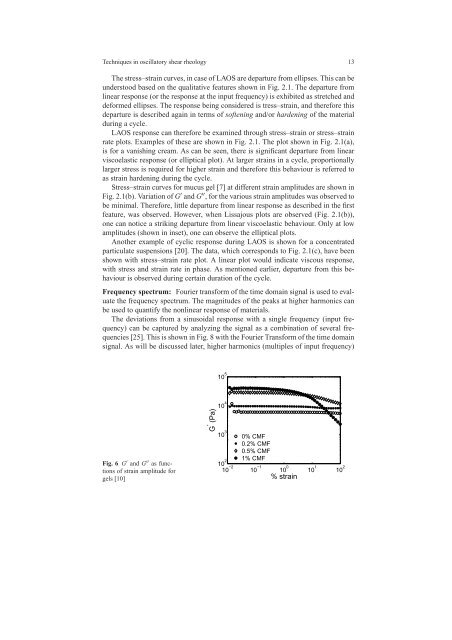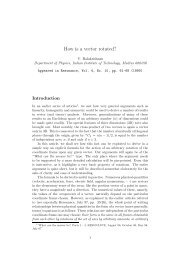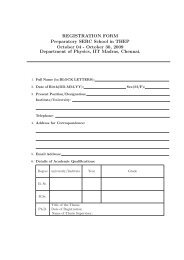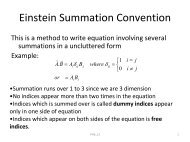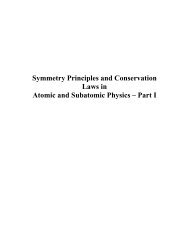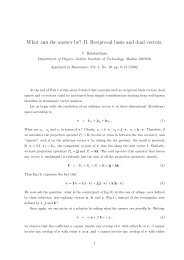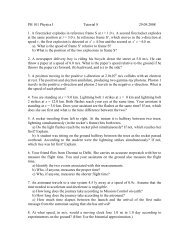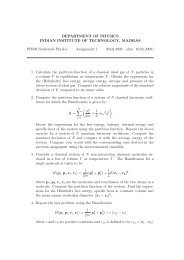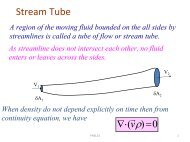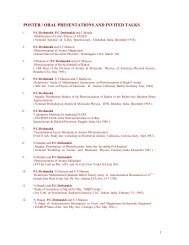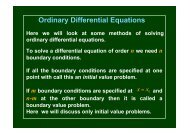Techniques in oscillatory shear rheology - Indian Institute of ...
Techniques in oscillatory shear rheology - Indian Institute of ...
Techniques in oscillatory shear rheology - Indian Institute of ...
You also want an ePaper? Increase the reach of your titles
YUMPU automatically turns print PDFs into web optimized ePapers that Google loves.
<strong>Techniques</strong> <strong>in</strong> <strong>oscillatory</strong> <strong>shear</strong> <strong>rheology</strong> 13The stress–stra<strong>in</strong> curves, <strong>in</strong> case <strong>of</strong> LAOS are departure from ellipses. This can beunderstood based on the qualitative features shown <strong>in</strong> Fig. 2.1. The departure froml<strong>in</strong>ear response (or the response at the <strong>in</strong>put frequency) is exhibited as stretched anddeformed ellipses. The response be<strong>in</strong>g considered is tress–stra<strong>in</strong>, and therefore thisdeparture is described aga<strong>in</strong> <strong>in</strong> terms <strong>of</strong> s<strong>of</strong>ten<strong>in</strong>g and/or harden<strong>in</strong>g <strong>of</strong> the materialdur<strong>in</strong>g a cycle.LAOS response can therefore be exam<strong>in</strong>ed through stress–stra<strong>in</strong> or stress–stra<strong>in</strong>rate plots. Examples <strong>of</strong> these are shown <strong>in</strong> Fig. 2.1. The plot shown <strong>in</strong> Fig. 2.1(a),is for a vanish<strong>in</strong>g cream. As can be seen, there is significant departure from l<strong>in</strong>earviscoelastic response (or elliptical plot). At larger stra<strong>in</strong>s <strong>in</strong> a cycle, proportionallylarger stress is required for higher stra<strong>in</strong> and therefore this behaviour is referred toas stra<strong>in</strong> harden<strong>in</strong>g dur<strong>in</strong>g the cycle.Stress–stra<strong>in</strong> curves for mucus gel [7] at different stra<strong>in</strong> amplitudes are shown <strong>in</strong>Fig. 2.1(b). Variation <strong>of</strong> G ′ and G ′′ , for the various stra<strong>in</strong> amplitudes was observed tobe m<strong>in</strong>imal. Therefore, little departure from l<strong>in</strong>ear response as described <strong>in</strong> the firstfeature, was observed. However, when Lissajous plots are observed (Fig. 2.1(b)),one can notice a strik<strong>in</strong>g departure from l<strong>in</strong>ear viscoelastic behaviour. Only at lowamplitudes (shown <strong>in</strong> <strong>in</strong>set), one can observe the elliptical plots.Another example <strong>of</strong> cyclic response dur<strong>in</strong>g LAOS is shown for a concentratedparticulate suspensions [20]. The data, which corresponds to Fig. 2.1(c), have beenshown with stress–stra<strong>in</strong> rate plot. A l<strong>in</strong>ear plot would <strong>in</strong>dicate viscous response,with stress and stra<strong>in</strong> rate <strong>in</strong> phase. As mentioned earlier, departure from this behaviouris observed dur<strong>in</strong>g certa<strong>in</strong> duration <strong>of</strong> the cycle.Frequency spectrum: Fourier transform <strong>of</strong> the time doma<strong>in</strong> signal is used to evaluatethe frequency spectrum. The magnitudes <strong>of</strong> the peaks at higher harmonics canbe used to quantify the nonl<strong>in</strong>ear response <strong>of</strong> materials.The deviations from a s<strong>in</strong>usoidal response with a s<strong>in</strong>gle frequency (<strong>in</strong>put frequency)can be captured by analyz<strong>in</strong>g the signal as a comb<strong>in</strong>ation <strong>of</strong> several frequencies[25]. This is shown <strong>in</strong> Fig. 8 with the Fourier Transform <strong>of</strong> the time doma<strong>in</strong>signal. As will be discussed later, higher harmonics (multiples <strong>of</strong> <strong>in</strong>put frequency)10 5 % stra<strong>in</strong>Fig. 6 G ′ and G ′′ as functions<strong>of</strong> stra<strong>in</strong> amplitude forgels [10]G ′ (Pa)10 410 30% CMF0.2% CMF0.5% CMF1% CMF10 210 −2 10 −1 10 0 10 1 10 2


